- Suitiable for: Non-technical professionals (Product Managers, Marketers, Customer Service) or beginners in AI.
What You'll Achieve
By following the steps in this guide, you will:
- Understand the core concept of RAG.
- Set up your own minimal but effective knowledge base.
- Build a no-code RAG chatbot that can fetch information from your documents and provide well-founded answers in real time.
Introduction: Why RAG is a "Game Changer"
The Problem: Limitations of Standard LLMs
- One issue is “hallucinations,” where the model invents facts or refers to information that doesn’t exist.
- Another problem is that many models are trained up to a certain date, so they don’t know about newer events, research, or trends.
- These limitations can make it hard to trust AI-generated responses.
The Solution: Introducing RAG
RAG (Retrieval-Augmented Generation) pulls in up-to-date facts as required, dramatically increasing accuracy and ensuring the answers reflect the latest information you provide.
So if you’ve ever struggled with AI models that produce outdated, irrelevant, or factually shaky responses, you’re certainly not alone. That’s where RAG comes in, offering a method to keep your Chatbot and AI agent constantly updated, relevant, and accurate.
Before we begin, let's explore what RAG is and why it's beneficial.
What is RAG? A Simple Explanation
RAG, short for Retrieval-Augmented Generation, is an advanced AI framework that integrates retrieved knowledge with generative large language models (LLMs) to respond to user enquiries. These tools allow companies to enhance customer support and streamline internal processes more effectively.
- Retrieve: The system searches for relevant information in a specified knowledge base. Think of it like a custom search engine that only looks within your private data.
- Augment: The retrieved information is then added to the prompt or input that the AI model sees.
- Generate: Using both the original user question and the newly found data, the LLM generates a response that is far more likely to be accurate and up to date.
A Visual Aid: How Does RAG Work?
A simple diagram in your mind might look like this:
- User Query → 2. Retriever (scans the Knowledge Base) → 3. Knowledge Chunks (relevant snippets returned) → 4. LLM (combines user query + snippets) → 5. Final Answer
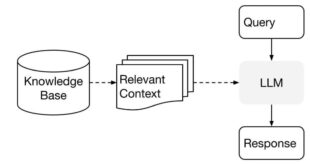
In essence, RAG addresses the problem of hallucinations and outdated knowledge by further grounding the AI's responses in curated documents. This pattern ensures that the model is not overly dependent on what it "thinks" it knows but can instead rely on factual sources you've authorized.
The Core Components Explained
Let's dig into the key building blocks under the RAG framework:
-
The Knowledge Base
At the heart of every RAG system is a collection of data—your "library" of documents. This data could be anything: PDFs, text files, web pages, or even transcribed audio. The key requirement is that it represents accurate, up-to-date information in an area you care about. For example, in a customer support setting, your knowledge base might include your product's user manuals or FAQ documents. -
The Retriever (The "Librarian")
The second major component is the retriever—a system that locates the most relevant documents or snippets from your knowledge base. In modern RAG workflows, this often involves transforming text into vector embeddings. These embeddings act like "digital fingerprints" for the meaning of your content, enabling the retriever to identify the pieces of text that best match a user's query. Think of the retriever as a supercharged search engine that looks for semantic rather than purely keyword matches. -
The LLM (The "Brain")
Finally, there is the large language model itself, sometimes referred to as the generator. This is where all the text synthesis magic happens. You could use a model like GPT-4 or Claude, or any other advanced language model. The critical difference, compared to a standard LLM usage scenario, is that the model is not left on its own. Instead, it is primed with just the right context retrieved from your knowledge base. This combined context dramatically increases the likelihood that the response the model generates is accurate, directly addressing the user's query using the relevant data you have available.
Why RAG is Critical for Scalable Business AI?
How RAG Chatbots Differ from Traditional Chatbots
The traditional chatbots follow pre-set rules, like “press 1 for sales department”, or use generic answers from public data. As a result, the bot frequently gives irrelevant or outdated responses, besides sounding too robotic.
A RAG chatbot fixes this dilemma by searching for the latest information first instead of guessing. Based on this retrieved knowledge, it generates clear and natural answers.
For instance, if an employee asks, “How many annual leaves do I get?” A traditional bot might say, “Please contact HR.” However, a RAG bot would search the latest company policy and provide the answer, like “You are entitled to 20 annual leaves per year, as per the employee handbook.”
And that is why RAG chatbots have become so useful for enterprise chatbots. They enable companies to deliver intelligent, up-to-date, and trustworthy interactions at scale.
Key Benefits in Enterprise RAG
💡Accuracy & Trustworthiness
- Reduces Hallucinations: Grounds responses in enterprise-specific documents (PDFs, wikis, databases), minimizing AI "fabrications."
💡Cost Efficiency
- No Full Retraining: Leverages existing documents instead of expensive model fine-tuning.
- Scales Support: Automates responses to routine queries (HR policies, IT troubleshooting), freeing staff for complex tasks.
💡Data Security & Compliance
- Access Controls: Restricts chatbot access to authorized documents.
- Auditability: Tracks queries/responses for compliance (GDPR, HIPAA, ISO, etc).
💡Enhanced Productivity
- 24/7 Self-Service: Resolves employee/customer queries instantly.
- Faster Onboarding: New hires query policies/procedures without manual searching.
💡Customization & Scalability
- Domain-Specific Answers: Trained on internal jargon, workflows, and use cases.
- Handles Complex Queries: Combines semantic search (intent understanding) with generative power for nuanced responses.
Use Cases: Examples of RAG Chatbots
Wondering how a RAG chatbot do wonders for a forward-looking business? Take a look at the 2 practical examples of RAG chatbots in an enterprise setting.
1. Customer Support Bot
A customer support RAG chatbot can respond to queries about the company’s services, policy updates, and other information. Based on the user’s query, it searches the latest documents in the company’s database to generate an up-to-date answer right away.
So, customers get faster and more accurate help, while companies enhance reliability by handling more requests automatically.
2. Internal Knowledge Assistant
A specific RAG chatbot can act as an assistant for the HR department to deal with employees’ queries. It provides the latest information about the policies, salary slips, leave structures, onboarding steps, and compliance requirements.
This can significantly reduce HR workload and ensure information consistency across the enterprise.
GoInsight’s Role in Simplifying Enterprise RAG
GoInsight.ai is a no-code AI platform designed to help businesses build powerful, secure, and scalable RAG chatbots. It has made the whole task of building a RAG chatbot by combining all the key processes in a single, unified interface.
Now, even a non-technical user can make intelligent bots that can retrieve real-time information from internal data sources and generate accurate, human-like responses.
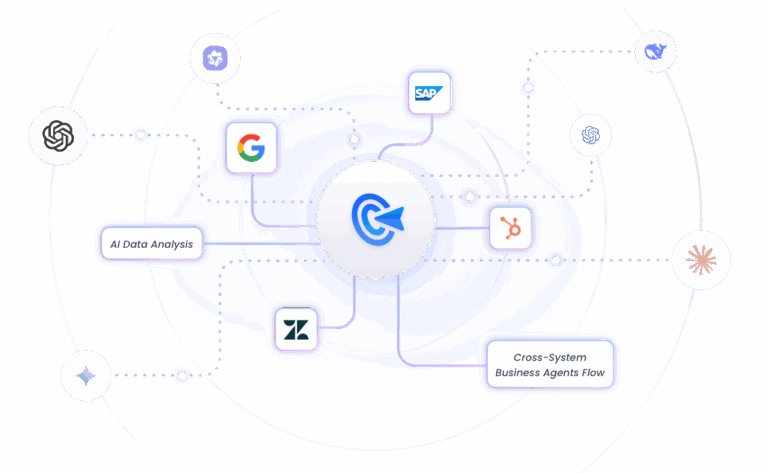
Key Features
- Enterprise-grade security includes data encryption, secure storage, and compliance audits
- Supports data retrieval from numerous external sources for building a domain-specific RAG
- Built-in support for Microsoft Azure OpenAI, Gemini, Claude, and other advanced LLM models
- Offers Role-Based Access Control (RBAC) and document-level permissions
- It can handle thousands of documents and users with ease, making it ideal for both small and large enterprises
How to Build Your Enterprise RAG Chatbot (No-Code) with GoInsight.ai
Now that you know what a RAG chatbot is, the next step is to build one for your business. Below are the detailed steps to create a responsive RAG bot without needing any coding expertise:
Prerequisites
Before proceeding, be sure to:
- Identify use cases or objectives of the chatbot, like whether it will be customer service bot, internal HR assistance, or whatever is expected from this bot.
- Gather structured and unstructured data sources, like company documents, databases, PDFs, web pages, product manuals, and so on. This data will be injected into the Knowledge Base.
- Access to the GoInsight.ai platform
Step-By-Step Guide to Build Knowledgebase RAG Chatbot
Step 1. Create a Knowledge Base
You need to first create a knowledge base first which serves as a data source from where LLMs can retrieve information when needed. he quality of your Knowledge Base determines the accuracy of AI’s responses.
To create a Knowledge Base:
- Visit GoInsight.ai and log in.
- On the left menu, click Knowledge Base and select New Category.
- Give it a name and hit Create.
Step 2: Add Content to Knowledge Base
The next step is to add content to the Knowledge Base.
- GoInsight.ai offers three options to add content: Create, Upload Document, and Import from Websites.
- Choose the relevant option to proceed. You can use data from all three sources, if needed. GoInsight will automatically split, chunk, and embed the content.

Note that it may take the platform several minutes to upload your data. For further information, click How to Add Content to Knowledge Base
Step 3: Train Your Data
Once the data is added, the status bar displays “Waiting for training." For that:
- Click the File name and hit “Save and train.”
- Wait for the process to finish.
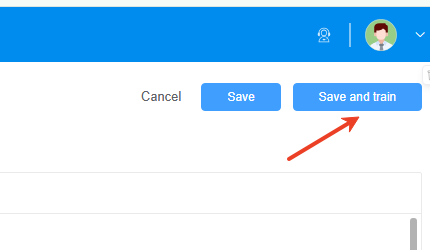
If you want to learn how to customize data in the knowledge base, refer Manage Knowledge Base.
Step 4: Configure Retrieval Settings
It’s recommended to fine-tune the bot to make it retrieve the most relevant and accurate data fragments based on the user's query. Besides adding a knowledge base, some additional options include:
- Top-K retrieval: Choose how many document chunks are fetched. The default value is 3, and the range is 1 to 10.
- Confidence threshold: It helps filter low-relevance content. The higher the threshold, the more accurate the results. Its range is 0 to 1.
- Similarly, you can customize the Output Variables.
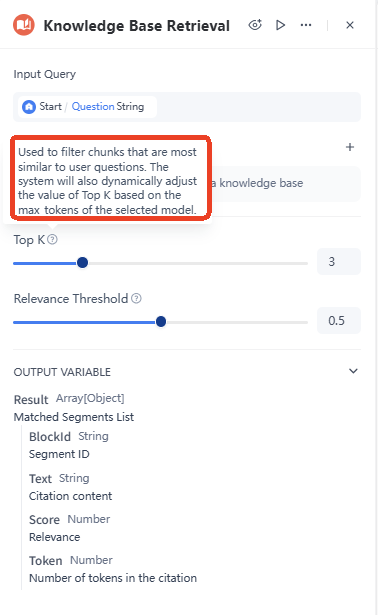
For more information, explore how to configure.
Step 5: Create GoInsight.ai RAG Chatbot
After creating a Knowledge Base in GoInsight.ai, you can proceed to building a RAG chatbot. To do that:
- On the Quick Bot tab, click New Bot.
- Now, select General Bot and click Next.
Step 6: Customize The Bot
The next step is to give a unique name to the bot that signifies its objective, like “HR Assistant.” To make sure the bot is tailored to your specific business needs, complete all the settings, including:
- Basic Settings
- Data Sources
- Choose LLM Model
- Set Prompt
- Content Moderation
- Permissions
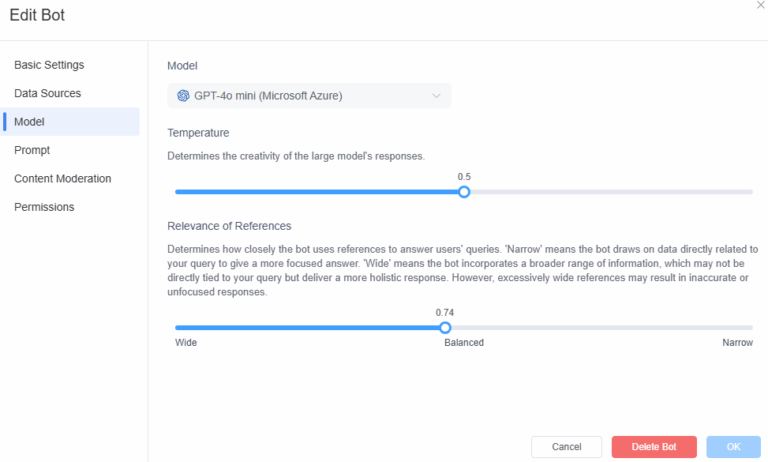
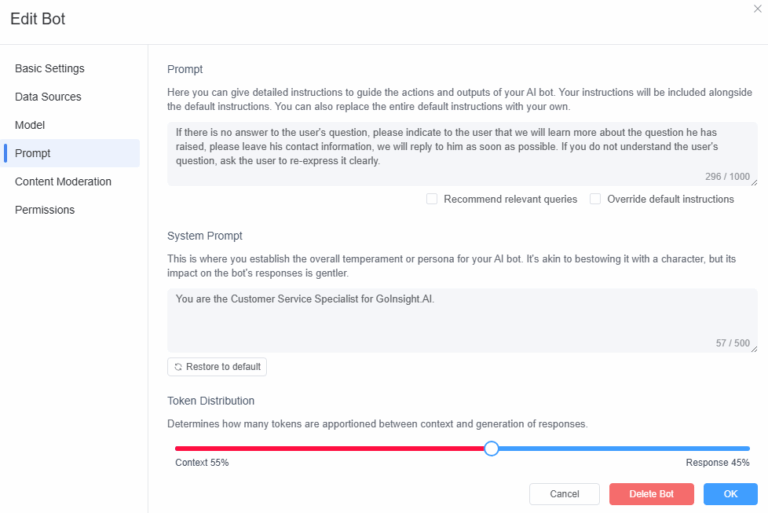
Review each interface and carefully fill in the necessary information. Here are the detailed instructions to understand each aspect of these RAG chatbot settings.
Step 7: RAG Chatbot Testing
And voila, you have just finished building a RAG chatbot for enterprise with GoInsight.ai. However, it’s best to test the efficiency of this new RAG bot. For that:
- Click the bot name to enter its chat screen.
- Here, test the bot with a wide range of scenarios and inputs to confirm everything is working perfectly.
Remember that GoInsight.ai can automatically detect the language in which users are communicating and respond in that specific language.
Step 8: Share Chatbot
If everything is up to your expectations, it’s time to deploy the chatbot. GoInsight.ai offers several methods for integrating the RAG chatbot with your business, including a URL link, iFrame code, and chat widget code.
- Click the " Share" icon under Operations and select "+ New Share."
- Adjust the bot’s style, such as the color, font size, as needed.
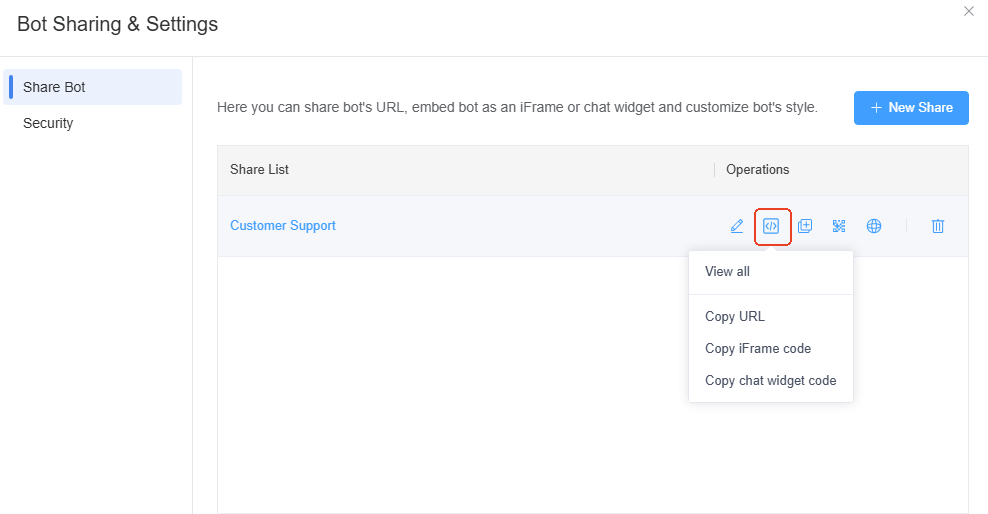
- Now, click the " </>" icon to choose the desired sharing option.
Note: For additional security, you can restrict the bot access by adding a password or IPs under the “Security” tab.
And that’s everything you need to know about building a perfect RAG bot through GoInsight.ai. For more details, visit How to Build a Quick Chatbot.
What's Next? From Simple Chatbot to Powerful Assistant
Having successfully built a bare-bones RAG Chatbot, you might be asking, "Where do I go from here?" The possibilities are immense:
- Adding More Data: Expand your knowledge base with additional documents. This might include product catalogs, research papers, or wiki-style internal knowledge. The richer your data, the more value your Chatbot can provide.
- Prompt Engineering & Tuning: Carefully designed prompts were crucial to ensure the model used only retrieved facts and didn't hallucinate.
- Assess Bot’s Performance Regularly: It’s best to keep evaluating the quality of the bot’s output to make sure it provides accurate results.
- Real-World Applications: Think bigger: a RAG Chatbot can power customer service bots, internal help desks, marketing analytics, or educational tools.
Conclusion: You've Unlocked a Superpower
You've just taken a significant leap into the world of RAG. Think back to where we started: AI models that occasionally hallucinate or rely on outdated knowledge. Now, you have a process that evolves beyond these limitations—retrieving relevant data in real time, then generating accurate, context-aware responses. This setup is much like giving your AI an open-book exam at every turn. The synergy between retrieval and generation offers a level of reliability and trustworthiness that standard LLM usage often can't match.
Remember the main points:
- RAG is short for Retrieval-Augmented Generation.
- Knowledge Base + Retriever + LLM = your new best friend in delivering timely, accurate, and well-structured answers.
- Implementation can be simple. You don't need to be a machine learning expert to set up a basic RAG Chatbot using available low-code platforms.
Keep learning, experimenting, and iterating. The more data you feed into your knowledge base and the more you refine your retrieval process, the better and more nuanced your AI agent will become. You now hold a flexible, powerful tool that can transform how you interact with and disseminate information—revolutionizing everything with GoInsight.AI from workplace productivity to customer engagement.
FAQs
Q1. How to ensure the accuracy of RAG Chatbot responses and prevent "hallucinations"?
The best way to overcome the issue of hallucinations or incorrect responses is to enable citation generation, customize knowledge retrieval regularly, and monitor feedback via the admin dashboard.
Q2. What types of external knowledge sources does GoInsight support for integration?
GoInsight.ai supports a wide range of external knowledge sources for integration, including:
- Upload or creat documents.
- Import from websites
Q3. Do I need a technical team to maintain the Chatbot?
Absolutely, not. GoInsight.ai is designed specifically to allow non-technical users to build and maintain the chatbot without any assistance. However, developers always get the advantage when it comes to integrating the bot with third-party tools.
Q4. Is it possible to extend and upgrade the functionality of an already built Chatbot?
To do that, you should upload the latest documents to the knowledge base, customize knowledge retrieval processes, and enable role-specific responses or multi-lingual outputs. If it’s not working, try switching the LLMs or adding a new prompt logic.





Leave a Reply.